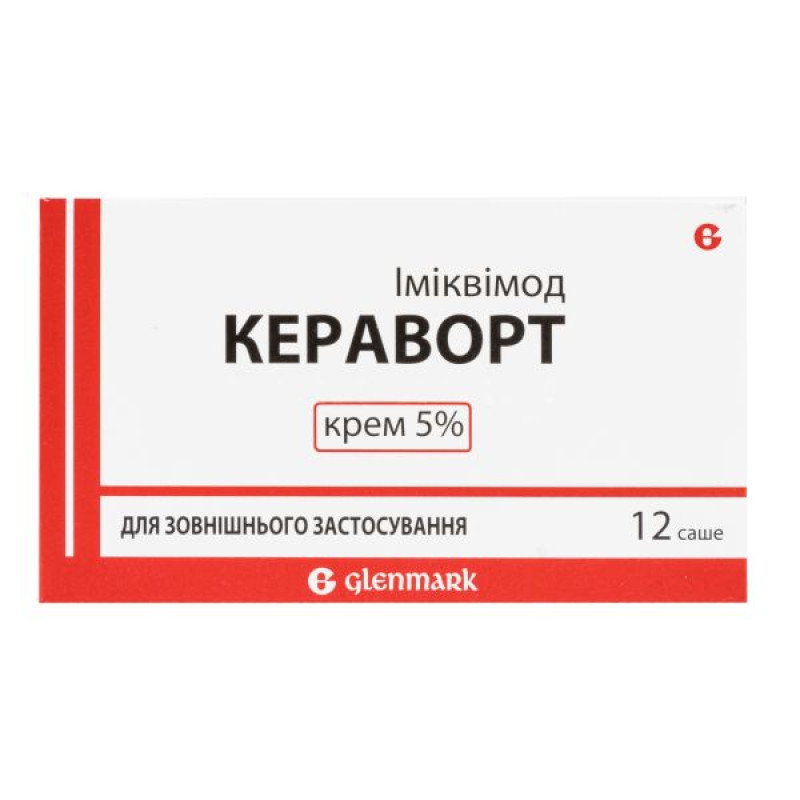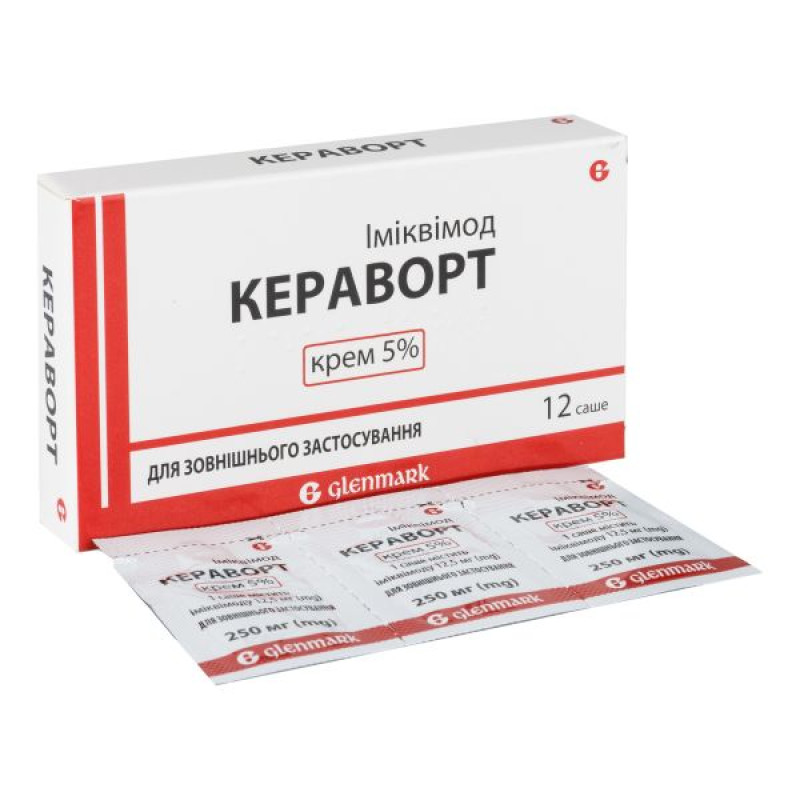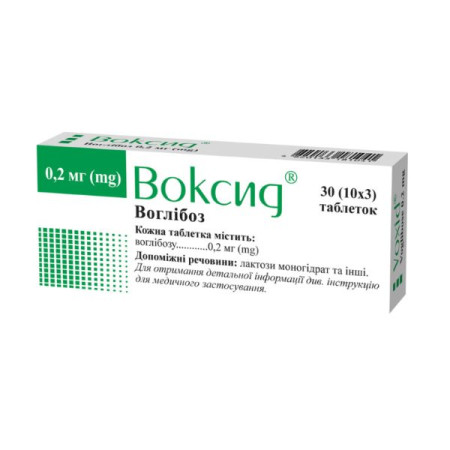Keraworth cream 5% 0.25 sachet No. 12

Instructions for Keravort cream 5% 0.25 sachet No. 12
Composition
active ingredient: imiquimod;
1 sachet (250 mg of cream) contains imiquimod 12.5 mg;
excipients: sorbitan stearate, isostearic acid, cetyl alcohol, stearyl alcohol, white soft paraffin, polysorbate 60, methylparaben (E 218), propylparaben (E 216), glycerin, xanthan gum, benzyl alcohol, purified water.
Dosage form
Cream.
Main physicochemical properties: white or almost white soft cream.
Pharmacotherapeutic group
Chemotherapeutic agents for topical use. Imiquimod.
ATX code D06B B10.
Pharmacological properties
Pharmacodynamics.
Imiquimod is an immune response modifier. Imiquimod does not exhibit direct antiviral activity; its action is due to the induction of the synthesis of interferon-alpha (IFNα) and other cytokines.
Pharmacokinetics.
Less than 0.9% of radiolabeled imiquimod is absorbed through the skin after a single dose.
A small amount of the drug that enters the systemic bloodstream is excreted without delay by the kidneys and through the intestines in a ratio of approximately 3: 1. The concentration of the drug in the blood serum after single or multiple external application did not reach a quantifiable level (> 5 ng/ml).
Indication
The drug is indicated for local treatment:
external genital and perianal condylomata acuminata;
small superficial basal cell carcinomas (sBCC);
Clinically typical, without signs of hyperkeratosis or hypertrophy, actinic keratoses (AKs) located on the skin of the face or scalp in patients with a normally functioning immune system in cases where the effectiveness and/or acceptability of cryotherapy is limited due to the size or number of lesions, and other local treatment methods are contraindicated or less appropriate.
Contraindication
Hypersensitivity to imiquimod or to any other components of the drug.
Interaction with other medicinal products and other types of interactions
The interaction of imiquimod with other drugs has not been studied. Since imiquimod stimulates the immune system, the cream should be prescribed with caution to patients receiving immunosuppressants.
Minimal absorption through the skin should limit interactions with systemic drugs.
Application features
Contact with the mucous membranes of the eyes, lips and nose should be avoided.
Imiquimod may exacerbate inflammatory processes on the skin.
The cream should be used with caution in patients with autoimmune diseases and patients who have undergone organ transplantation.
The benefit of imiquimod treatment for these patients should be weighed against the risk of organ rejection or graft-versus-host disease.
Treatment with the cream is not recommended if the skin has not healed after previous medical or surgical treatment. Applying the cream to affected skin may increase the systemic absorption of imiquimod, which will increase the risk of adverse reactions.
The use of an occlusive dressing is not recommended.
In rare cases, an acute inflammatory reaction, including oozing or erosion, may occur after multiple applications of imiquimod cream. Local acute inflammatory reactions may accompany or even precede systemic flu-like symptoms, including malaise, fever, nausea, myalgia, and chills.
Imiquimod should be used with caution in patients with anemia.
External genital warts.
Treatment of men with genital warts in the foreskin area is possible only if daily hygiene procedures are carried out. In their absence, stricture may occur or the difficulty of foreskin retraction may increase, which can lead to phimosis and stricture.
Treatment of urethral, intravaginal, cervical, rectal, or intraanal warts is not recommended. Treatment of tissues with open ulcers or wounds is not indicated until they are completely healed.
Skin reactions are common during treatment with the cream. Therefore, if the skin reaction becomes intolerable, the area where the cream was applied should be washed with warm water and soap. Treatment with the cream can be resumed after the skin reactions have subsided.
There are no clinical data on the application of the cream immediately after treatment of genital and perianal warts with other medications.
Imiquimod cream should be washed off before sexual intercourse. It may reduce the effectiveness of condoms and vaginal diaphragms. Other methods of contraception should be used.
Repeated treatment with the cream is not recommended for patients with weakened immunity.
When treating genital warts in HIV-positive patients, the use of the cream was not always effective.
Superficial basal cell carcinomas.
When treating basal cell carcinoma, the cream should be applied no closer than 1 cm from the hairline, the edge of the eyes, mouth or nose.
There is a correlation between the speed of recovery and the occurrence of local skin reactions (e.g. erythema). These local skin reactions may be associated with the stimulation of a local immune response. Treatment may be interrupted for a few days due to patient discomfort or severe local skin reactions. Treatment may be resumed after the skin reactions have subsided.
The clinical outcome of the treatment can be assessed after the skin has recovered approximately 12 weeks after the end of treatment.
There are no clinical data on the use of the cream in immunocompromised patients.
There are no clinical data on the use of the cream in patients with recurrent and previously treated basal cell carcinoma, therefore therapy in this category of patients is not recommended.
Large tumors (>7.25 cm2) are less responsive to imiquimod treatment.
The treated skin surface area should be protected from exposure to ultraviolet radiation.
Actinic keratosis.
If the lesions are clinically atypical for actinic keratosis or there is suspicion of malignancy, a biopsy should be performed.
When treating actinic keratosis, the cream should not be applied to the eyelids, the inside of the nose or ears, or the red border of the lips.
There is limited data on the use of the cream on areas other than the face or scalp. Data on the treatment of axillary keratosis and on the hands do not support efficacy.
Imiquimod is not recommended for the treatment of actinic lesions with marked hyperkeratosis or hypertrophy, which are seen in keratoma corneum.
During treatment and until complete recovery, the affected skin differs significantly from healthy skin. Local skin reactions are normal, but the severity of these reactions usually decreases during treatment and they disappear after discontinuation of treatment with the cream. There is a relationship between the speed of recovery and the manifestation of local skin reactions (e.g. erythema). These local reactions may be associated with stimulation of the local immune response. Treatment may be interrupted for a few days due to patient discomfort or severe local skin reactions. Treatment may be resumed after the skin reactions have subsided.
Each treatment period should not exceed 4 weeks, regardless of missed doses or rest periods.
The clinical result of the treatment can be assessed after the skin has recovered approximately 4 to 8 weeks after the end of treatment.
There are no clinical data on the use of the cream in patients with weakened immunity.
Areas of skin to be treated must be protected from ultraviolet radiation.
The excipients methylparaben (E 218) and propylparaben (E 216) may cause allergic reactions (possibly delayed). Cetyl alcohol and stearyl alcohol may cause local skin reactions (e.g. contact dermatitis).
Use during pregnancy or breastfeeding
Use during pregnancy or breastfeeding is not recommended.
If necessary, use of the drug should be discontinued.
Ability to influence reaction speed when driving vehicles or other mechanisms
During treatment, caution should be exercised when driving or working with other mechanisms, as well as performing work that requires increased concentration of attention, due to the possible appearance of weakness and dizziness.
Method of administration and doses
The frequency and duration of use is determined by the doctor individually for each patient.
External genital warts in adults.
Imiquimod cream should be applied three times a week (for example, Monday, Wednesday, and Friday or Tuesday, Thursday, and Saturday) before bedtime and left on the skin for 6 to 10 hours. Treatment with imiquimod cream should be continued until the genital and perianal warts have cleared, but for no more than 16 weeks for each outbreak.
The cream should be applied in a thin layer and rubbed into the clean surface of the areas affected by warts until completely absorbed. The cream should be applied only to the affected areas. For 6-10 hours after applying the cream to the skin, you should avoid taking a shower or bath. After the specified period, the cream should be washed off with warm water and soap. Applying an excessive amount of cream or prolonged contact with the skin may cause a reaction at the site of application. The cream from one sachet is enough to apply to an area of skin of 20 cm2. You cannot reuse the cream from a previously opened sachet. Before and after applying the cream, you must wash your hands with warm water and soap.
Men who have not undergone the rite of circumcision should, during treatment for genital warts, pull back the foreskin and wash the area under it daily.
Superficial basal cell carcinoma in adults.
Before applying imiquimod cream, wash the affected areas with soap and let them dry. Apply a sufficient amount of cream to the entire affected surface, including healthy skin 1 centimeter from the edge of the tumor. The cream should be rubbed into the affected area until completely absorbed. The cream should be applied before bedtime, it should remain on the skin for 8 hours. During this time, you should avoid taking a shower or bath. After the specified period, the cream should be washed off with warm water and soap.
Do not reuse the cream from a previously opened sachet. Wash your hands with warm water and soap before and after applying the cream.
The response of the treated tumor to the cream should be assessed 12 weeks after the end of treatment. If the treated tumor does not respond sufficiently, another treatment should be used.
If a local skin reaction to the cream causes increased discomfort to the patient or if infection of the treated surface occurs, treatment should be interrupted for several days.
Actinic keratosis in adults.
Treatment is prescribed and monitored by a doctor. Imiquimod cream should be applied three times a week (e.g. Monday, Wednesday and Friday or Tuesday, Thursday and Saturday) before going to bed for 4 weeks and left on the skin for 8 hours. A sufficient amount of cream should be applied to the entire affected area. Actinic keratosis should be assessed 4 weeks after stopping treatment. If any symptoms persist, treatment should be continued for another 4 weeks.
The maximum recommended dose is one sachet. The maximum recommended treatment is 8 weeks.
If a local acute inflammatory reaction occurs or if infection of the treated area occurs, treatment should be discontinued. In the latter case, appropriate measures should be taken. Each treatment period should not exceed 4 weeks due to missed doses or rest periods.
If the lesions do not respond adequately to treatment at follow-up 4 to 8 weeks after the second treatment period, another treatment should be considered.
Before applying the cream, wash the affected areas with soap and let them dry. Apply a sufficient amount of cream to the entire affected surface. The cream should be rubbed into the affected area until completely absorbed. The cream should be applied before bedtime and should remain on the skin for approximately 8 hours. During this time, you should avoid taking a shower or bath. After the specified period, the cream should be washed off with warm water and soap.
Do not reuse the cream from a previously opened sachet. Wash your hands with warm water and soap before and after applying the cream.
If a dose is missed, the patient should apply the cream as soon as he remembers and then continue treatment according to the usual schedule. However, it should be remembered that the cream can be applied no more than once a day.
Children.
Contraindicated in children under 18 years of age.
Overdose
Overdose is unlikely due to low absorption of the drug. Continuous overdose with topical application of the cream may cause severe local skin reactions.
Accidental ingestion of a 200 mg dose of imiquimod, equivalent to approximately 16 sachets, may cause nausea, vomiting, headache, myalgia and fever. The most clinically serious adverse effect of multiple 200 mg doses is hypotension, which resolved after oral or intravenous infusion therapy.
Side effects
Adverse reactions are defined by frequency as: very common (≥1/10), common (≥1/100 to <1/10) and uncommon (≥1/1000 to <1/100).
External genital warts. When the cream was applied 3 times a week, the most common adverse reactions were reactions at the application site, namely erythema, erosion, desquamation and swelling. Some systemic adverse reactions were also observed, including headache, flu-like symptoms and myalgia.
Delayed skin reactions, mainly erythema, have also been observed in non-lesional areas that may have come into contact with imiquimod cream. Most of these reactions resolved within 2 weeks after the end of treatment. However, in some cases these reactions were severe and caused dysuria in women.
Infections and invasions.
Common: susceptibility to bacterial infections.
Uncommon: herpes simplex, genital candidiasis, vaginitis, bacterial infection, mycosis, upper respiratory tract infection, vulvitis.
Blood and lymphatic system disorders: Uncommon: lymphadenopathy.
Metabolic disorders: Uncommon: anorexia.
Psychiatric disorders: Uncommon: insomnia, depression.
Nervous system disorders: Common: headache.
Uncommon: paresthesia, dizziness, hemicrania, drowsiness.
Hearing and balance disorders: Uncommon: tinnitus.
Vascular disorders: Uncommon: hyperemia.
Respiratory system disorders: Uncommon: pharyngitis, rhinitis.
Gastrointestinal: Common: nausea.
Uncommon: vomiting, abdominal pain, diarrhoea, painful defecation, rectal disorders.
On the skin and subcutaneous tissue.
Uncommon: pruritus, dermatitis, folliculitis, erythematous rash, eczema, increased sweating, urticaria.
On the part of muscle and connective tissue.
Common: muscle pain.
Uncommon: joint pain, back pain.
Renal and urinary disorders: Uncommon: dysuria.
Uncommon: male genital pain, penile disorder, dyspareunia, erectile dysfunction, uterine and vaginal prolapse, vaginal pain, atrophic vaginitis, vulvar disorder.
General reactions: Very common: itching and pain at the application site.
Common: burning and irritation at the application site, fatigue.
Uncommon: hyperthermia, influenza-like symptoms, pain, asthenia, malaise, chills.
Superficial basal cell carcinoma. When using the cream 5 times a week, there were reactions at the application site, namely: erythema, erosion, severe scabbing and desquamation. Patients also experienced some systemic adverse reactions, including back pain and flu-like symptoms.
Infections and invasions.
Common: susceptibility to bacterial infections, acne.
From the lymphatic system.
Common: lymphadenopathy.
Psychiatric disorders: Uncommon: irritability.
Gastrointestinal: Uncommon: nausea, dry mouth.
Skin and subcutaneous tissue disorders: Uncommon: dermatitis.
Musculoskeletal and connective tissue disorders: Common: back pain.
General reactions: Very common: itching at the application site.
Common: burning, irritation and pain at the application site, erythema, application site bleeding, application site papules, application site paresthesia, application site rash.
Uncommon: flu-like symptoms, application site discharge, inflammation, application site swelling, scabbing, application site destruction, blistering, lethargy.
Actinic keratosis. When the cream was applied 3 times a week for two courses of 4 weeks, reactions at the application site, namely itching and burning, were observed. Severe erythema and severe crusting and desquamation were observed frequently. Some systemic adverse reactions, including muscle pain, were also observed.
Infections and invasions.
Uncommon: susceptibility to bacterial infections, acne, influenza, rhinitis.
Blood and lymphatic system disorders: Uncommon: lymphadenopathy.
Metabolic disorders: Common: anorexia.
Psychiatric disorders: Uncommon: depression.
Nervous system disorders: Common: headache.
On the part of the organs of vision. Uncommon: eyelid edema, conjunctival inflammation.
Respiratory system: Uncommon: sore throat, nasal congestion.
Gastrointestinal: Common: nausea.
Uncommon: diarrhea.
On the skin and subcutaneous tissue.
Uncommon: erythema, actinic keratosis, facial edema, skin ulceration.
Musculoskeletal and connective tissue disorders: Common: muscle and joint pain.
Uncommon: pain in extremities.
General reactions: Very common: itching at the application site.
Common: fatigue, burning, irritation and pain at the application site, erythema, application site reaction.
Uncommon: application site bleeding, papule formation, paresthesia, hyperthermia, asthenia, chills, dermatitis, application site discharge, application site hyperesthesia, edema, scabbing and scarring, application site swelling and ulceration, blistering, application site heat, discomfort, inflammation.
Adverse reactions observed in all indications included hypo- and hyperpigmentation after application of the cream, alopecia at or around the application site. In isolated cases, decreases in hemoglobin, white blood cell count, absolute neutrophil count and platelet count were observed, but did not require intervention. Elevated liver enzymes and exacerbation of autoimmune conditions were reported in isolated reports. Severe skin reactions reported in clinical trial reports included erythema multiforme, Stevens-Johnson syndrome and cutaneous lupus erythematosus.
Expiration date
2 years.
Storage conditions
Store at a temperature not exceeding 25 ° C. Do not freeze.
Keep out of reach of children.
Packaging
250 mg of cream in a sachet. 12 or 24 sachets in a cardboard box.
Vacation category
According to the recipe.
Producer
Glenmark Pharmaceuticals Ltd./Glenmark Pharmaceuticals Ltd.
Address
Plot No. S-7, Colvale Industrial Estate, Colvale, Bardez, Goa – 403 513, India.
There are no reviews for this product.
There are no reviews for this product, be the first to leave your review.
No questions about this product, be the first and ask your question.











